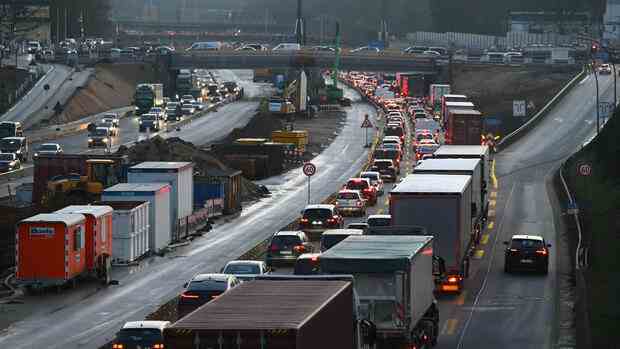In 2022, the transport sector emitted 11 million tonnes of CO2 more than required. The industry achieves its goals.
(Photo: dpa)
Berlin According to a study, the increased use of coal-fired power plants as a substitute for gas has thwarted the German climate targets for 2022. Although overall energy consumption fell by almost five percent, mainly because of the high prices, the use of coal and oil canceled out the greenhouse gas savings, according to an analysis by the think tank Agora Energiewende published on Wednesday.
The transport and building sector was again unable to meet its targets last year. According to provisional figures, Germany produced 761 million tons of greenhouse gas, almost exactly as much as in 2021. The self-imposed upper limit for 2022 was missed by around five million tons.
Traffic remains the major problem area among the sectors: According to Agora, CO2 emissions at 150 million tons were well above the 139 million tons permitted under the Climate Protection Act. The reasons for missing the target are the traffic volume, which increased again after the corona decline, and the lack of political instruments to reduce emissions. The industrial sector, on the other hand, has met its targets. This is a result of energy savings and more efficiency. Nevertheless, more is needed to achieve the targets for 2030.
>> Read here: CO2 disadvantage of e-cars compensated after 60,000 kilometers according to ADAC
Top jobs of the day
Find the best jobs now and
be notified by email.
In its study, the think tank also writes that the speed at which new solar systems are installed must more than double, that wind power systems on land should more than triple and that offshore wind farms even more than eightfold. This is the only way to achieve the self-imposed climate goals of the federal government. The study entitled “The energy transition in Germany: State of affairs 2022” will be published this Wednesday in Berlin and is available to the German Press Agency.
Balance in the expansion of renewable energies mixed
“The expansion of renewable energies is the foundation for everything else,” said Agora’s Germany director, Simon Müller. The pace must increase in order to reduce greenhouse gas emissions there, but also to cover the increasing demand for electricity, for example for industrial processes. Through the increased use of electricity, climate-damaging energy sources are to be pushed back – be it in electric cars, heat pumps for heating or in industry.
Overall, renewable energies were expanded significantly faster last year than in 2021, by 9.6 gigawatts, 61 percent more than in the previous year. The total installed capacity of renewables at the end of 2022 was 148.2 gigawatts. However, the balance sheet varies greatly depending on the area.
The largest increase in renewable energies last year was in solar systems. According to preliminary data, systems with a capacity of 7.2 gigawatts were newly commissioned, an increase of 44 percent compared to the previous year. In order to achieve the capacity target of 215 gigawatts by 2030 laid down in the Renewable Energy Sources Act, an average increase of 18.6 gigawatts per year would be necessary from 2023, Agora calculates.
A capacity of 2 gigawatts was added to onshore wind turbines last year, around 21 percent more than in the previous year. That was the third increase in a row, albeit from a low level. In order to achieve the 2030 target of 115 gigawatts, plants with a capacity of around 7.1 gigawatts would have to be built per year.
Hardly any progress on offshore wind farms
Wind energy at sea has been slow, with only 0.3 gigawatts of new capacity in 2022 according to preliminary data. According to the Wind Energy at Sea Act, there should be at least 30 gigawatts by 2030, which would correspond to an annual increase of 2.7 gigawatts on average .
The Federal Government’s Expert Council had already warned in autumn that Germany was in danger of missing its climate targets for 2030. By then, emissions of greenhouse gases are to be reduced by 65 percent compared to 1990. In addition, by then 80 percent of gross electricity consumption should be covered by renewable sources such as wind and sun.
More: According to an expert report, Minister Wissing violates the Climate Protection Act
